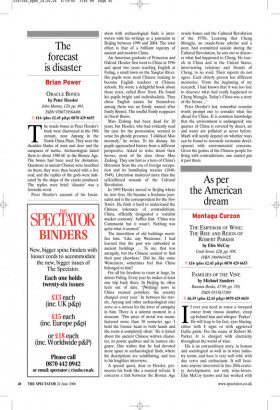The forecast is disaster
Brian Power
ORACLE BONES by Peter Hessler John Murray, £20, pp. 491, ISBN 9780719564406 ✆ £16 (plus £2.45 p&p) 0870 429 6655 The oracle bones in Peter Hessler’s book were discovered in the 19th century, near Anyang in the North China Plain. They were the shoulder blades of oxen and deer and the carapaces of turtles. Archaeologists dated them to about 1300 BC in the Bronze Age. The bones had been used for divination. Questions in ancient Chinese were inscribed on them; they were then heated with a live coal, and the replies of the gods were indicated by the shape of the cracks produced. The replies were brief; ‘disaster’ was a favourite word.
Peter Hessler’s account of his fascin ation with archaeological finds is interwoven with his writings as a journalist in Beijing between 1999 and 2004. The total effect is that of a brilliant tapestry of ancient and modern China.
An American graduate of Princeton and Oxford, Hessler first went to China in 1996 and spent two years teaching English at Fuling, a small town on the Yangtze River. His pupils were rural Chinese training to become English teachers at Chinese schools. He wrote a delightful book about those years, called River Town. He found his pupils bright and individualistic. They chose English names for themselves; among them was an Emily, named after Emily Brontë. The soulful Emily reappears in Oracle Bones.
Mao Zedong had been dead for 20 years, but Hessler, who had evidently read the case for the prosecution, seemed to sense his ghostly presence. ‘I disliked Mao intensely,’ he writes. To his dismay, his pupils approached history from a different perspective. Asked to write about their heroes, most of his class chose Mao Zedong. They saw him as a hero of China’s liberation from the era of foreign occupation and its humiliating treaties (18401949). Liberation mattered more than the self-inflicted wounds of the Cultural Revolution.
In 1999 Hessler moved to Beijing where he now lives. He became a freelance journalist and is the correspondent for the New Yorker. He finds it hard to understand the Chinese tolerance of contradictions. China, officially designated a ‘socialist market economy’, baffles him. ‘China was Communist but it wasn’t. Nothing was quite what it seemed.’ The demolition of old buildings mortifies him: ‘Like any Westerner, I had learned that the past was embodied in ancient buildings ... To me, that was antiquity, but the Chinese seemed to find their past elsewhere.’ Did he, like some Westerners, sometimes feel that China belonged to him?
For all his freedom to roam at large, he misses Fuling. Every year he makes at least one trip back there. In Beijing he often feels out of date. ‘[Writing] news in China seemed pointless: the country changed every year.’ In between his travels, Anyang and other archaeological sites serve as a retreat for the lover of antiquity in him. There is a solemn moment in a museum: ‘This piece of metal was manufactured more than 30 centuries ago. I hold the bronze head in both hands and the room is completely silent.’ He is lyrical about the ancient Chinese written character, its poetic qualities and its austere elegance. One wishes that he had devoted more space to archaeological finds, where his descriptions are scintillating, and less to his lengthier interviews.
A special quest, dear to Hessler, permeates his book like a musical refrain. It concerns a link between the Bronze Age oracle bones and the Cultural Revolution of the 1970s. Learning that Cheng Mengjia, an oracle-bone scholar and a poet, had committed suicide during the Cultural Revolution, he sets out to discover what had happened to Cheng. He travels in China and in the United States, interviewing relations and friends of Cheng, to no avail. Their reports do not agree. Each elderly person has different memories. ‘From the beginning of my research, I had known that it was too late to discover what had really happened to Cheng Mengjia. Today’s China was a story of the future...’ Peter Hessler’s last, somewhat oracular words prompt one to consider what lies ahead for China. It is common knowledge that the environment is endangered: one quarter of China is covered by desert, air and water are polluted as never before. Much will surely depend on whether ways can be found to reconcile economic development with environmental concerns. Given the genius of the Chinese people for living with contradictions, one cannot put it past them.



















































 Previous page
Previous page